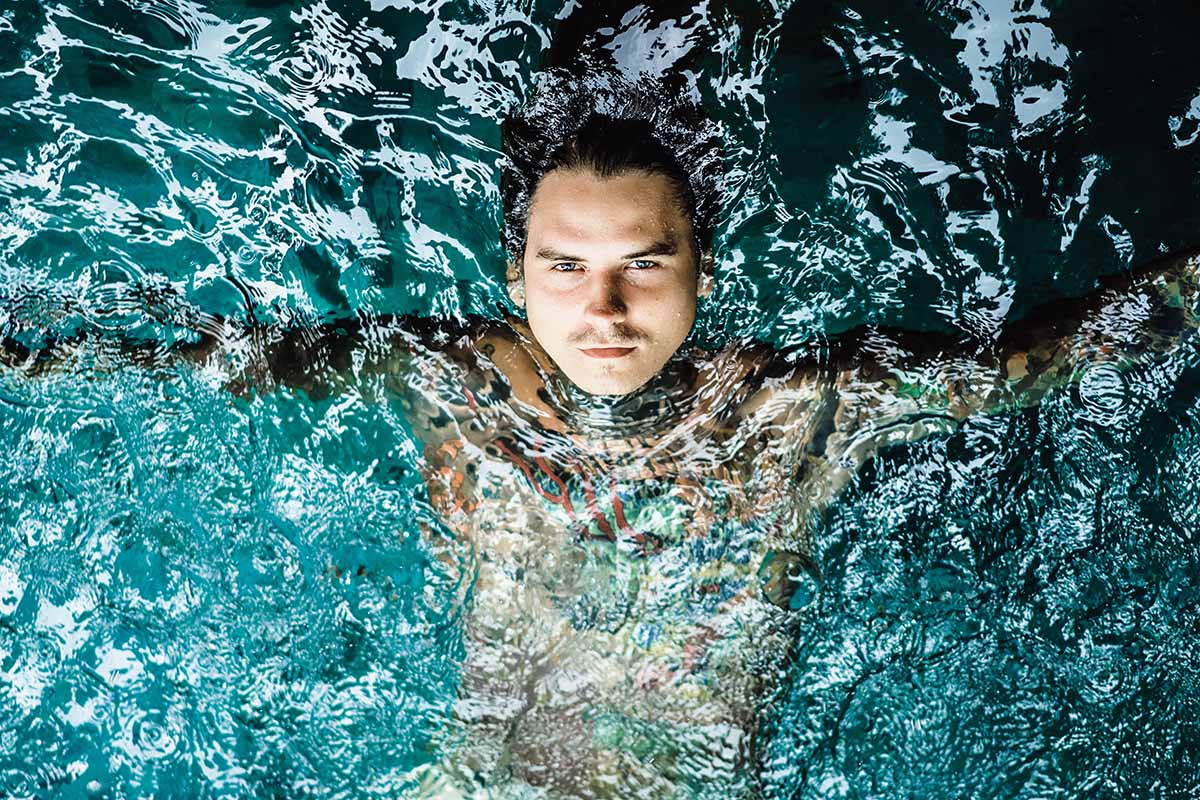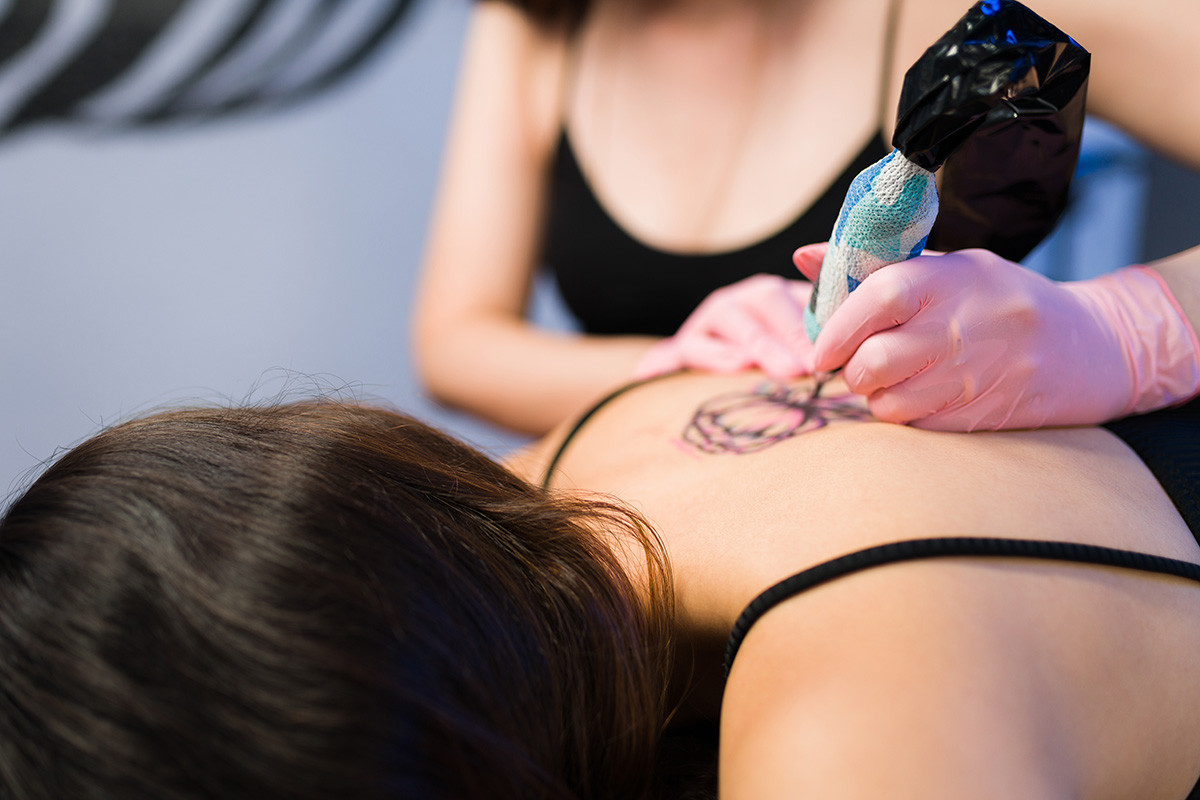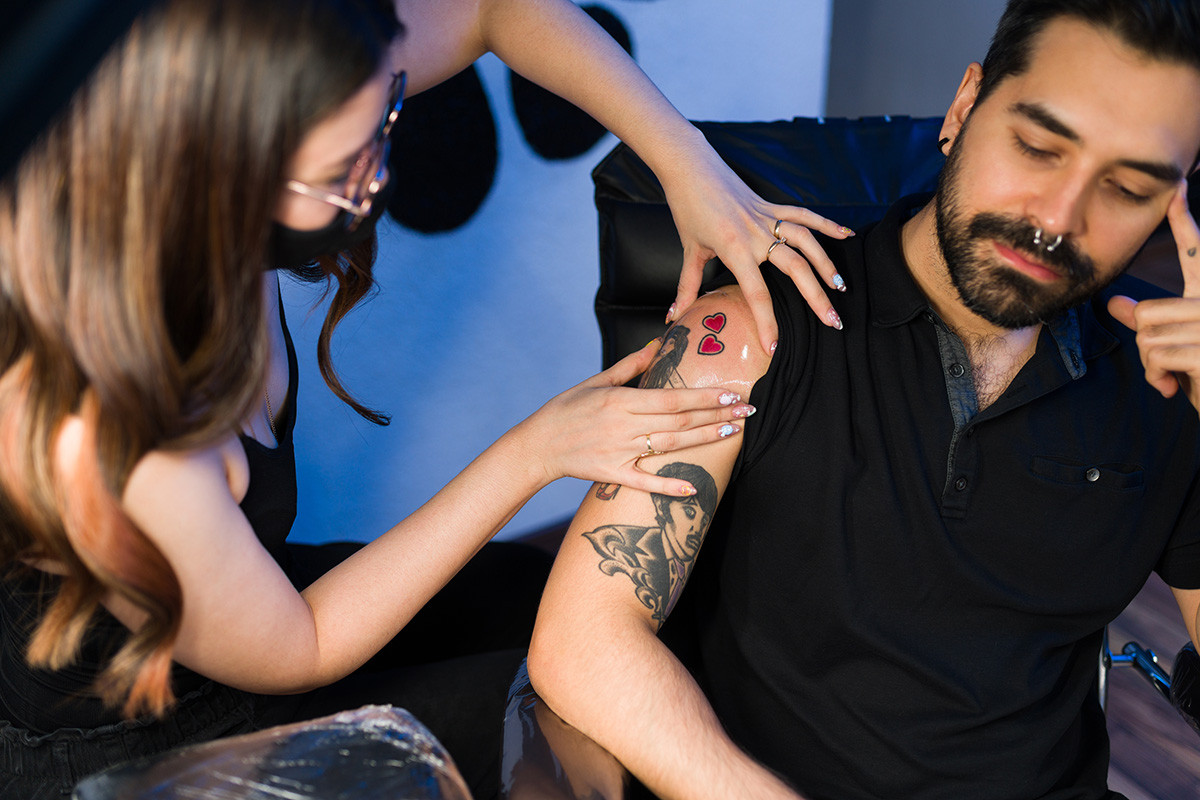Getting a tattoo is a thrilling experience, and you’re probably eager to show it off. But, Can You Get Into A Pool After A Tattoo? At tattooat.com, we understand the importance of proper tattoo aftercare to maintain the vibrancy and health of your new body art. The answer is generally no; swimming too soon can lead to infections and damage. This guide will provide you with everything you need to know about protecting your new tattoo, understanding the healing process, and ensuring your skin art stays stunning for years to come with essential tattoo protection tips and healing timelines.
1. Diving In: Understanding the Tattoo Healing Timeline
 A person getting a new tattoo and the healing process
A person getting a new tattoo and the healing process
Getting a new tattoo is an exciting venture. It’s crucial to remember that a new tattoo is essentially an open wound. Proper aftercare is crucial for both the health and appearance of your skin. Tattoo artists recommend waiting at least 2-4 weeks before submerging your new ink in swimming pools, hot tubs, or open water. This allows the skin to heal and minimizes the risk of infection and damage.
Of course, healing times can vary. The size and location of the tattoo, the individual’s skin type, and the quality of aftercare provided all play a role. Understanding the stages of tattoo healing and the factors affecting healing time is vital for the best possible result.
1.1. What Are The Stages Of Tattoo Healing?
The tattoo healing process is a dynamic journey, generally involving swelling, discomfort, and fluid secretion initially, progressing to itching and peeling before necessitating continuous aftercare. Complete recovery can span from 2 to 4 weeks, or extend up to 6 months for some individuals. During this period, it’s important to avoid swimming and other activities that can irritate the skin and prolong the healing process.
Open water poses the greatest risk of bacterial infection. Infections can delay the healing process and even damage your tattoo. Be patient and wait until your tattoo is fully healed before diving in. Think of it as investing in the long-term beauty of your tattoo.
1.2. What Factors Affect Tattoo Healing Time?
Several factors can influence how quickly a tattoo heals:
-
Size of the tattoo: Larger tattoos naturally require more time to heal.
-
Location of the tattoo: Areas with more friction or movement (e.g., joints) may take longer.
-
Aftercare: Consistent and proper aftercare is crucial for reducing healing time.
-
Individual skin types: Some skin types may heal faster than others.
It’s essential to monitor the healing process closely. If you have any concerns about the progress of your tattoo’s healing, consult your tattoo artist before submerging into the water.
2. What Are The Risks Of Swimming With A New Tattoo?
Swimming with a fresh tattoo can expose your new artwork to potential issues. Water can dry out the skin, leading to increased itching, flaking, and scabbing. These issues can also cause fading, patchiness, and blurred lines in your fresh ink. This is definitely not the desired outcome.
Besides the physical discomfort and potential damage to your tattoo, swimming with a fresh tattoo can also increase the risk of bacterial infections. Pools, lakes, and oceans are teeming with bacteria. Your healing tattoo is an open wound that’s susceptible to these invaders. It’s best to avoid swimming until your tattoo is fully healed to protect your tattoo and ensure a smooth healing process.
2.1. Bacterial Infections and Open Wounds: Why Are They a Concern?
Tattoos are considered open wounds. They involve breaking the skin and introducing a foreign substance (ink) into the body. Submerging your healing tattoo in water can expose it to harmful bacteria lurking in pools, lakes, and oceans. This can lead to irritation, infection, and other complications that can harm your tattoo and prolong the healing process.
Keeping your new tattoo clean and protected from water exposure is essential to minimize the risk of bacterial infections. Waterproof dressings and bandages can help shield your tattoo from bacteria and other contaminants while swimming. When it comes to your tattoo’s health, it’s always better to be safe than sorry.
2.2. Chlorine and Salt Water Effects: Understanding The Impact
Chlorine and salt water can have negative effects on your fresh tattoo, potentially causing:
| Effect | Description |
|---|---|
| Irritation | Chlorine and salt can irritate the sensitive skin of a new tattoo. |
| Fading | Prolonged exposure can cause the ink to fade, reducing the vibrancy of your tattoo. |
| Discoloration | Chemicals in pool water can react with the tattoo ink, leading to unwanted color changes. |
| Ink Leaching | Water can draw ink out of the tattoo, resulting in blurred lines and a less defined design. |
Even swimming in a chlorinated pool poses a risk to your healing tattoo. Chlorine doesn’t kill all bacteria.
Chlorine and salt water can also have a drying effect on the skin, exacerbating any existing irritation and prolonging the healing process. To ensure your tattoo heals properly and maintains its vibrant appearance, it’s best to avoid swimming until your tattoo is fully healed.
3. How Can You Protect Your New Tattoo While Swimming?
 A person protecting their new tattoo while swimming with waterproof dressings and bandages
A person protecting their new tattoo while swimming with waterproof dressings and bandages
If you absolutely must swim before your tattoo is fully healed, there are precautions you can take to protect your new ink. While not ideal, using waterproof dressings and bandages can help shield your tattoo from water and bacteria while swimming. Be sure to remove the dressing immediately after swimming and clean your tattoo thoroughly to minimize the risk of infection.
Swimming with a fresh tattoo isn’t recommended. Taking these precautions doesn’t guarantee that your tattoo will be safe from infection or damage. If you must swim, be sure to take the necessary steps to protect your artwork.
3.1. Choosing The Right Waterproof Dressings and Bandages
Waterproof dressings and bandages can be a lifesaver if you need to swim with a new tattoo. These coverings are designed to provide a barrier between your tattoo and the water. They help keep your new ink safe from bacteria and other contaminants.
Some of the best waterproof dressings for a new tattoo include:
-
Saniderm Tattoo Aftercare Bandage
-
Recovery Derm Shield Tattoo Aftercare Bandage
-
Tattoo Aftercare Waterproof Bandage
-
Nexcare Tattoo Bandages
-
Nuanchu Waterproof Bandage
Apply the dressing before swimming and remove it immediately afterward. Change it regularly to ensure your tattoo remains protected.
3.2. Post-Swim Care: Essential Steps
Post-swim care is crucial to maintaining the health and appearance of your tattoo. Follow these steps after swimming:
- Gently wash the tattoo with warm water and a mild, fragrance-free soap.
- Pat the area dry with a clean towel.
- Apply a thin layer of a fragrance-free moisturizer to keep the skin hydrated and promote healing.
Taking the necessary steps to protect your new ink can help ensure a smooth healing process. You can enjoy your beautiful tattoo for years to come.
4. Recognizing The Signs: Is Your Tattoo Ready For Swimming?
Once your tattoo has fully healed, you can safely enjoy swimming. Some key signs your tattoo is fully healed include:
-
Absence of redness
-
No itching
-
No scabbing
-
No flaking
-
A smooth, even appearance without any peeling
If unsure whether your tattoo is fully healed, consult your tattoo artist or a medical professional before taking the plunge. They can assess your tattoo’s healing progress and provide guidance on when it’s safe to dive in.
4.1. Key Visual Indicators To Look For
Visual indicators can help you determine whether your tattoo is ready for swimming. Look for signs such as:
-
No bubbling or degradation
-
No redness or peeling
-
A smooth, even appearance without any flaking or scabbing
If your tattoo meets these criteria, it’s likely healed and safe to expose to water.
Monitor your tattoo closely throughout the healing process. Contact your tattoo artist or a medical professional for advice if you have any concerns or notice any unusual symptoms.
4.2. Why Consulting Your Tattoo Artist Is a Good Idea
Your tattoo artist is an invaluable resource when determining whether your tattoo is ready for swimming. They have extensive experience with the healing process and can assess your tattoo’s progress. They can provide expert guidance on when it’s safe to expose your ink to water.
Don’t hesitate to swing by the studio where you had your tattoo done and let a professional check it for you if you’re unsure whether your tattoo is fully healed. It’s always better to err on the side of caution. Ensure your tattoo is fully healed before diving into the water.
5. Alternative Water Activities During Tattoo Healing Period
 A person enjoying alternative water activities during the tattoo healing period
A person enjoying alternative water activities during the tattoo healing period
If you’re eager to get in the water while your tattoo is healing but don’t want to risk damaging your new ink, there are alternative water activities you can engage in. Instead of swimming, consider:
- Taking gentle showers
- Avoiding direct water jets
Boiling tap water for cleansing is another option to minimize the risk of infection.
Keeping your new tattoo clean and protected from water exposure during the healing process is essential. You can still enjoy the water while ensuring your tattoo heals properly and looks its best by choosing alternative water activities.
6. Hot Tubs, Saunas, and Other Water Hazards: Proceed With Caution
Hot tubs and saunas may be relaxing. They can pose risks to your new tattoo if you indulge too soon after getting inked. The warm, moist environment in hot tubs and saunas can increase the risk of bacterial infections. It can also hinder the healing process of your tattoo. Waiting at least 3-4 weeks after getting a tattoo before entering a hot tub or sauna is recommended.
Protect your new tattoo and ensure it heals properly by avoiding hot tubs, saunas, and other water-based environments during the healing process. Once your tattoo is fully healed, you can enjoy all your favorite water activities without worry.
7. Exploring Tattoo Designs and Inspiration at tattooat.com
Looking for inspiration for your next tattoo? Or perhaps you want to understand different tattoo styles? Dive into the world of creative ink designs and discover endless possibilities to express your individuality. Check out tattooat.com for a wide range of tattoo designs, artist portfolios, and informative articles.
7.1. Finding The Perfect Tattoo Style For You
Choosing the right tattoo style is a personal journey. Whether you’re drawn to traditional styles, modern minimalist designs, or intricate realism, understanding different styles can help you make an informed decision. Learn about the history and techniques behind each style to find one that resonates with you.
7.2. Connecting With Talented Tattoo Artists
Finding a skilled tattoo artist is just as important as choosing the right design. Explore tattooat.com to connect with talented artists in your area. Browse their portfolios and read reviews to find an artist whose style and expertise align with your vision.
8. Real-World Experiences and Expert Opinions
To provide a comprehensive understanding of tattoo aftercare and swimming, let’s incorporate real-world experiences and expert opinions.
8.1. Case Studies and Anecdotes
- Case Study 1: A 25-year-old individual with a forearm tattoo swam in a chlorinated pool one week after getting inked. Despite using a waterproof bandage, they developed a mild infection, resulting in delayed healing and slight fading of the tattoo.
- Case Study 2: A 30-year-old with a back tattoo waited four weeks before swimming in the ocean. They experienced no complications and their tattoo healed perfectly, maintaining its vibrancy and detail.
- Anecdote: A tattoo artist shared that they’ve seen numerous cases of infected tattoos due to early swimming. They always emphasize the importance of waiting at least three weeks and using proper aftercare.
8.2. Expert Q&A
- Q: What’s the biggest mistake people make regarding tattoo aftercare and swimming?
- A: Not waiting long enough. People underestimate the risk of infection and the damage chlorine and salt water can cause.
- Q: Are there any specific types of tattoos that are more susceptible to damage from swimming?
- A: Tattoos with fine lines and intricate details are more prone to fading and blurring if exposed to water too soon.
- Q: What are some alternative water-related activities that are safe during the healing period?
- A: Gentle showers with mild soap are fine. Avoid soaking the tattoo and pat it dry immediately.
9. Debunking Common Tattoo Myths
There are many misconceptions about tattoo aftercare. Let’s address some common myths related to swimming:
- Myth 1: Applying a thick layer of petroleum jelly is enough to protect a tattoo while swimming.
- Fact: Petroleum jelly can trap bacteria and moisture, increasing the risk of infection. It’s not a substitute for a waterproof bandage.
- Myth 2: Salt water is good for healing tattoos.
- Fact: While salt can have antiseptic properties, the risk of infection from ocean bacteria outweighs any potential benefits.
- Myth 3: If a tattoo looks healed after a week, it’s safe to swim.
- Fact: The surface may appear healed, but the deeper layers of skin need more time to recover. Waiting at least two to four weeks is essential.
10. Long-Term Tattoo Maintenance and Care
Once your tattoo is fully healed, long-term maintenance is crucial to keep it looking its best.
10.1. Protecting Your Tattoo from the Sun
Sun exposure can cause tattoos to fade and lose their vibrancy. Always apply a high-SPF sunscreen to your tattoo before spending time outdoors.
10.2. Keeping Skin Hydrated
Hydrated skin helps keep your tattoo looking fresh. Regularly moisturize your tattoo with a fragrance-free lotion.
10.3. Regular Check-Ups
Pay attention to any changes in your tattoo’s appearance. If you notice fading, blurring, or other issues, consult your tattoo artist for advice.
Summary
Protecting your new artwork requires understanding the healing process of tattoos and the risks associated with swimming too soon after getting inked. Following proper aftercare guidelines, using waterproof dressings and bandages when necessary, and waiting until your tattoo is fully healed before submerging it in water are all essential. This helps ensure a smooth healing process and maintain the vibrant appearance of your tattoo.
Prioritizing the health and safety of your new tattoo is essential, whether you’re a seasoned ink enthusiast or a first-time tattoo recipient. Ensure your tattoo is ready for a swim before diving into the water. Patience pays off when preserving the beauty of your ink!
Ready to explore more stunning tattoo designs and connect with talented artists? Visit tattooat.com today and discover the perfect inspiration for your next piece of body art. From understanding tattoo styles to finding the right artist, tattooat.com is your ultimate resource for all things tattoos.
Frequently Asked Questions
1. What happens if you swim while your tattoo is healing?
Swimming with a new tattoo can be dangerous, exposing your wounded skin to bacteria in the water. This can cause infections ranging from mild to severe. It can also irritate the skin, resulting in major itching, oozing blisters, and hives. Avoid swimming entirely while your tattoo is healing to protect it.
2. Can I swim 7 days after getting a tattoo?
Waiting for your tattoo to fully heal, which can take at least two to four weeks, is advised before swimming in any kind of water. Going into the pool or ocean before then may put you at risk of infection due to bacteria or germs that can enter an open wound.
3. How long after getting a tattoo can you swim in chlorine?
Wait at least two weeks and up to four to six weeks after getting a tattoo before swimming in chlorine-filled water. Don’t risk infection by going into the pool or hot tub too early!
4. Can I use waterproof dressings to protect my tattoo while swimming?
Yes, you can use waterproof dressings to protect your tattoo while swimming. Make sure it’s fully healed before you do!
5. What are the risks of swimming with a fresh tattoo?
Swimming with a fresh tattoo carries the risk of bacterial infections, skin irritation, and damage to the design. It is best avoided for the first few weeks after getting a new tattoo. Taking the necessary precautions is important to ensure that your tattoo heals properly and looks its best. Taking the time to wait before swimming can help you avoid any potential problems.
6. How effective are waterproof bandages in preventing infection?
Waterproof bandages provide a barrier against bacteria, but they are not foolproof. Change them regularly and clean the tattoo after swimming to minimize risk.
7. What type of soap should I use to clean my tattoo after swimming?
Use a mild, fragrance-free antibacterial soap to gently cleanse the area. Avoid harsh chemicals and abrasive scrubbing.
8. Is it safe to use a tanning bed after my tattoo has healed?
Tanning beds can fade tattoos and damage the skin. Always use sunscreen or cover your tattoo completely.
9. How often should I moisturize my tattoo to keep it looking vibrant?
Moisturize your tattoo daily, especially after showering, to keep the skin hydrated and the ink looking fresh.
10. What are the signs of a tattoo infection that requires medical attention?
Signs of infection include excessive redness, swelling, pain, pus, and fever. Seek medical attention immediately if you experience these symptoms.